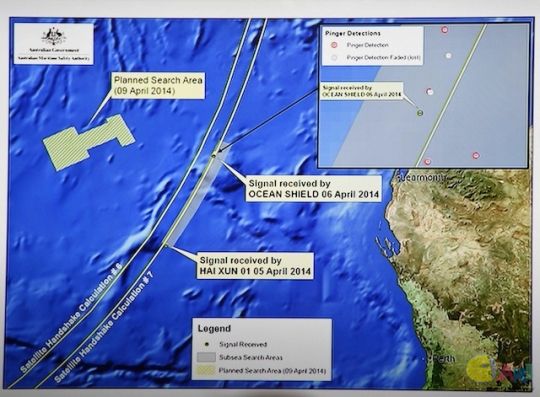 Searchers have time and tide against them as they narrow the hunt for a missing Malaysian Airlines jet using final "pings" from flight recorders soon to fall silent. Finding the boxes will be just the start of a challenge to pluck wreckage from the ocean that may stretch technology to its limits. For the second time since flight MH370 disappeared after leaving Kuala Lumpur on March 8, experts are having to rely on metronomic whispers from the plane's electronic systems to try to track it down. It was satellite pings that led searchers on the path south to the Indian Ocean where an Australian ship picked up possible pings from the recorders on April 5. Now, they are searching blindfolded in one of the most murky, noisy and isolated spots on Earth, three miles under water where the jet is assumed to have crashed with 227 passengers and 12 crew on board. Today, Australian officials said two new ping signals had been detected the previous day. The recorders' batteries are now about two days past their regular lifespan. Finding the recorders won't just help locate the jet. They record cockpit data that could help explain what happened to the plane and why it flew thousands of kilometres off its Kuala Lumpur-to-Beijing route. "Now that 30 days have passed we are in bonus time," said Anish Patel, head of Florida-based pinger maker Dukane Seacom. "The units are certified to last 30 days but there is a small design margin... (of) a few extra days of power." The first priority for search crews will be to cling onto the electronic signals long enough to narrow the area for more thorough sonar research. Australian ship Ocean Shield is using a "Towed Pinger Locator" sent by the US Navy – described by France as the most capable of its kind after it was used in the ultimately successful search for an Air France jet that crashed in the Atlantic in 2009. "The problem is not localising it, the problem is finding where to look in the first place," said Mike Davis-Marks, a former submarine commander in Britain's Royal Navy. It's a slow and exhausting process. Operators must separate a ping lasting just 9.3 milliseconds – a tenth of the blink of a human eye – and repeated every 1.08 seconds from the natural cacophony of the ocean, as well as disturbances from other search vessels. "The ocean is a noisy place," said Davis-Marks, former commander of a sister vessel to British hunter-killer submarine HMS Tireless which has been dispatched to assist in the search. "There is noise from everything, whether it's the ambient noise of the weather at the surface, or marine life like whales or the snapping noise of shrimps, not to mention other sea transport and low-flying aircraft." Plotting pings from the recorders is a comparatively simple task in shallow waters. At depths of up to 4,500 metres, the challenge is acute. Not only is that twice the range of the recorders' pinger, but the deeper the water, the harder it is to juggle vertical and horizontal angles, with the risk that readings become blurred. The range of the pinger is limited because it uses a relatively high frequency of 37.5KHz. In water, high-frequency sounds travel shorter distances, meaning the pinger signals can travel only 2,000-3,000 metres. To bring the US Navy's bright yellow ping detector within range of its target, the Ocean Shield's crew plays out a long cable to position it at depth. But experts say this can reduce the manoeuverability of the ship and hence the speed of operations. Standing by to take over as soon as the search area is narrowed sufficiently is an American underwater robot called Bluefin-21. It will build up a detailed acoustic image of the area using sophisticated "sidescan" sonar, hoping to repeat its success in finding a F-15 fighter jet which crashed off Japan last year. If it detects possible wreckage, it will be sent back to photograph it carefully in underwater conditions with extremely low light. But building up the necessary mosaic of thousands of high-definition photos in the undersea gloom can be a long and frustrating task. On one occasion during the search for Air France's lost flight AF447, in waters almost as deep as the southern Indian Ocean, a remote vehicle investigated signs of wreckage, only to find sea shells instead. Even with new pings, the prospects for retrieving MH370 wreckage quickly may be slim. The search for the Air France jet took almost two years in total. Nor, with doubts hovering over the distribution of roles in a Malaysian investigation, is it clear how the final recovery phase would be tackled, even if the lost Boeing 777 is found. The search for AF447 was only completed after a cash crisis that saw investigators trade down to a cheaper ship and accept indirect contributions from Airbus and the airline. The US Navy says it has not yet been asked to help with salvage, but experts say the Remora 6000, designed by naval contractor Phoenix International which lifted the black boxes, wreckage and bodies from AF447, remains one of the few options. The unmanned vehicle's history is a roll-call of deep-sea operations, including viewing the Titanic and recouping a Turkish F-14 Tomcat fighter, a Japanese rocket and an Israeli submarine. However, AF447 was found on a flat plain near a mountainous ridge. Given the Indian Ocean depth and terrain, any MH370 retrieval operation may be more difficult. Such deep-sea skills do not come cheaply, adding to what is already expected to be the costliest search in aviation history, likely stretching to hundreds of millions of dollars. The final recovery stage of the search for AF447 cost 6 million euros (RM26.73 million) in total – equating to more than US$250,000 (RM807,625) per day. – Reuters
|
ADVERTISEMENT